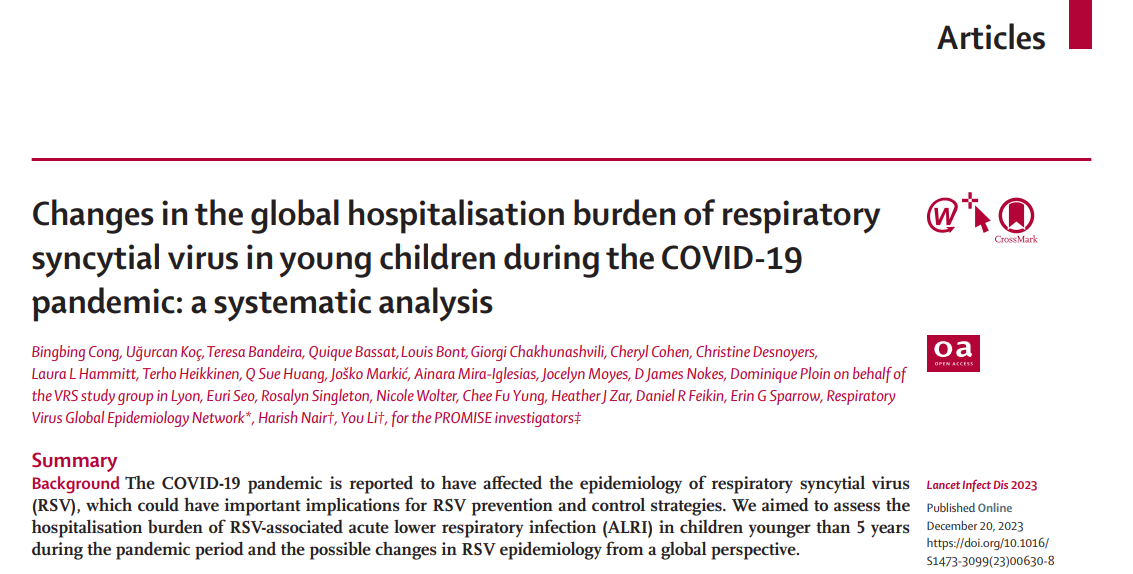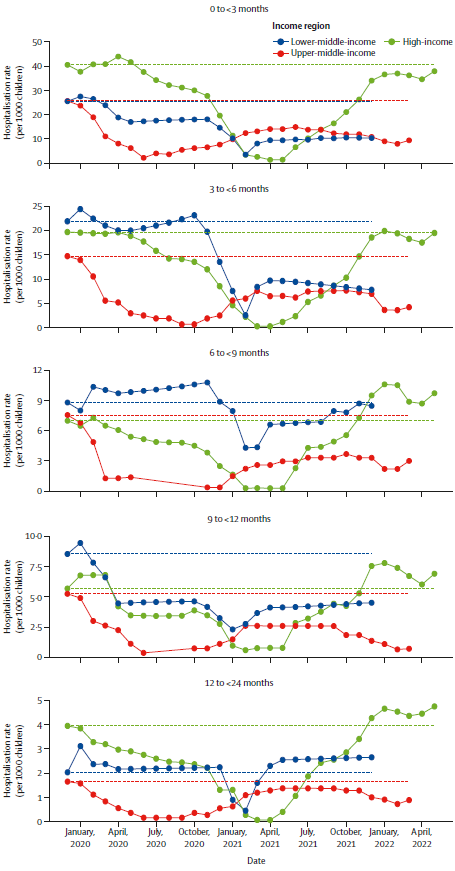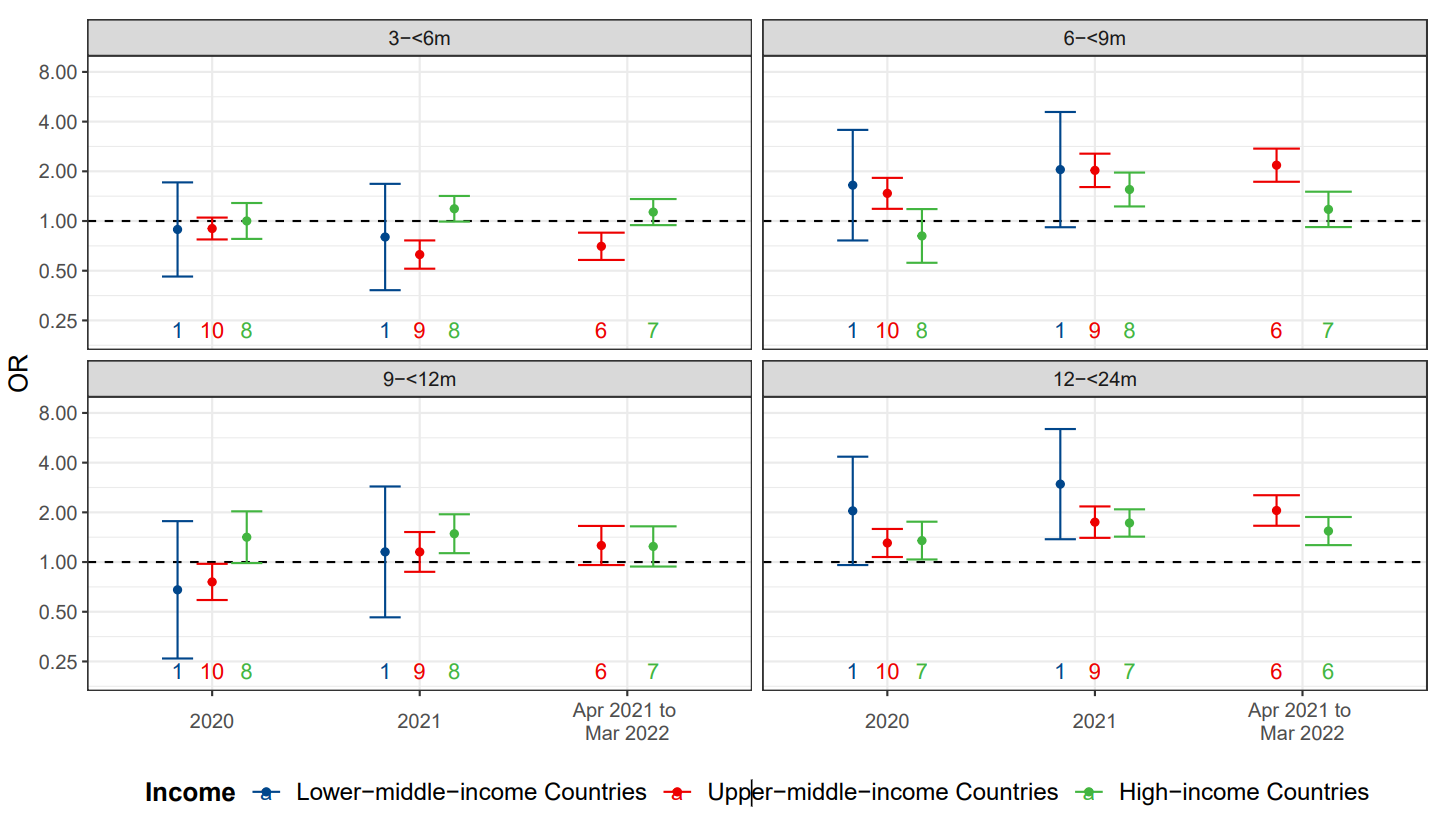The Lancet Infectious Diseases: Prof. You Li’s group and cooperators revealed the changes in global hospitalisation burden of respiratory syncytial virus (RSV) in young children during the COVID-19 pandemic
On December 20th, 2023, The Lancet Infectious Diseases (IF: 56.3), a leading international journal of infectious diseases, published online a research paper titled " Changes in the global hospitalization burden of respiratory syncytial virus in young children during the COVID-19 pandemic: a systematic analysis", by Professor You Li from School of Public Health, Nanjing Medical University, together with an international team. The research systematically analyzed, for the first time, the change of the epidemiological characteristics and hospitalization burden of respiratory syncytial virus (RSV) in children under five years during the COVID-19 epidemic from a global perspective. The findings could have important implications for RSV prevention and control strategies and RSV surveillance.

RSV disease burden before the COVID-19 pandemic
Respiratory syncytial virus (RSV) is the most common pathogen identified in infants and young children with acute lower respiratory infection, accounting for about 30% of all respiratory tract pathogens. Prof. You Li research team previously revealed, based on data up to and including 2019, that RSV contributes substantially to morbidity and mortality burden globally in children aged 0–60 months, especially during the first 6 months of life and in low- and middle-income countries (LMICs), which was explained by the poor access to care, cost of care and limited beds in hospitals (Li et al. Lancet 2022).
RSV disease burden during the pandemic period
On the basis of their previous work, the researchers included unpublished data on RSV epidemiology shared by RSV GEN (Respiratory Virus Global Epidemiology Network), and combined with systematic review, measured the changes in RSV epidemiology following the onset of the COVID-19 pandemic, including the incidence, age distribution, and disease severity of children hospitalized with RSV-associated ALRI during the pandemic, compared with the year 2019.
The study found that the hospitalization burden of RSV-associated acute lower respiratory infection (ALRI) in children younger than five years was significantly reduced across all income regions in 2020. However, these rates started to rise in 2021 and showed different trajectories by income region. Specially, in the high-income region, by March 2022, the annualized RSV hospitalization rates have increased to a level similar to 2019 (6.0/1000 [95%CI: 5.4–6.8] vs 5.0/1000 [3.6–6.8]), despite population mobility had not returned; by contrast, in middle-income countries, rates remained lower in the latest period with data up to March 2022 than in 2019, with comparable level of population mobility to 2019.

Figure 1. 12-month rates of children hospitalized with RSV-associated ALRI by age group and World Bank income region
Consistent with 2019, children younger than 6 months (primarily aged 0 to <3 months) continued to have the highest RSV hospitalization burden during the pandemic years. However, a significantly higher proportions of older children (aged 12 to <24 months) hospitalized with RSV-related ALRI was observed during the pandemic period, compared to 2019, with odds ratios ranging from 1.30 (95%CI: 1.07–1.59) to 2.05 (1.66–2.54).

Figure 2. Relative risk of RSV-associated ALRI hospitalization during the pandemic period by age group and World Bank income region
Furthermore, consistent patterns regarding changes in the proportions of severe outcomes (defined as RSV-associated ALRI requiring supplemental oxygen or requiring mechanical ventilation or ICU admission) during the pandemic years versus 2019 were not observed.
The varied changes in the hospitalization burden of RSV by income region and the changes in the age distribution of children hospitalized with RSV-associated ALRI highlight the importance of establishing (or re-establishing) RSV surveillance. Combined with the changes in population mobility, the findings suggested the negative impact of the COVID-19 pandemic on health-care systems and health-care accessibility, particularly in LMICs. The findings, together with other existing RSV studies, emphasized the widespread use of RSV prevention products in LMICs could have a substantial effect on reducing RSV disease burden.
Prof. You Li from School of Public Health, Nanjing medical university and Prof. Harish Nair from Centre for Global Health, Usher Institute, University of Edinburgh are the corresponding authors of the paper. Masters student. Bingbing Cong from School of Public Health, Nanjing medical university is the first author of the paper. The research was supported by EU Innovative Medicines Initiative Preparing for RSV Immunisation and Surveillance in Europe (PROMISE), Bill & Melinda Gates Foundation, and WHO.
Original link:https://authors.elsevier.com/sd/article/S1473-3099(23)00630-8

